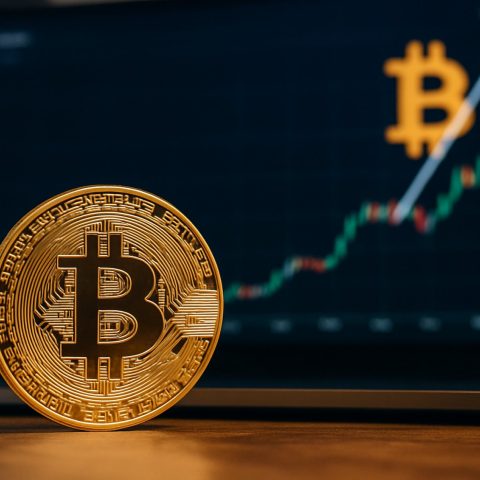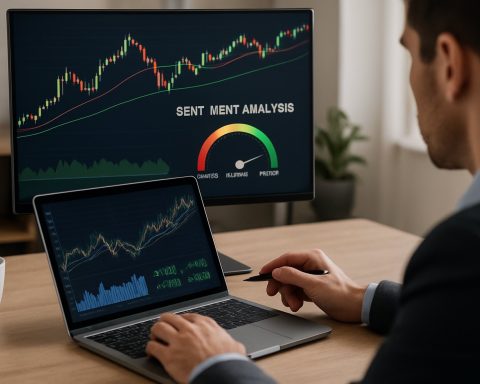- The US-China trade war continues to influence global markets, affecting commodity prices and inflation.
- Federal Reserve Chairman, Jerome Powell, maintains high interest rates due to persistent tariff effects on inflation.
- Bitcoin shows resilience amid economic volatility, serving as a potential safe haven and storing significant institutional investments.
- Economist Timothy Peterson predicts Bitcoin could reach $138,000, driven by macroeconomic trends and bond yield indices.
- US uses tariffs strategically against China, affecting global financial dynamics and causing shifts in bond markets.
- Progress in US cryptocurrency regulations may facilitate wider adoption and integration of digital currencies.
- Gold reaches new highs, though Bitcoin’s rise offers investors a diversified hedge against economic uncertainty.
- Smaller cryptocurrencies face challenges, emphasizing the need for careful evaluation of digital assets.
The dance between economic giants, the United States and China, has become a powerful catalyst for change in global markets. At the heart of this geopolitical play is the ongoing trade war initiated by former President Trump. This conflict, characterized by tit-for-tat tariffs, continues to reverberate across the global financial landscape, influencing everything from commodity prices to cryptocurrency valuations.
Envision Jerome Powell, the unflappable Chairman of the Federal Reserve, navigating stormy economic waters. He notes that the tariffs have unexpectedly stubborn effects on inflation, prompting the central bank to maintain high interest rates. These measures ripple through financial markets, painting a volatile picture that investors and policymakers must interpret and act upon.
Bitcoin, the digital gold, emerges as a haven against this storm of economic tension. Unlike traditional markets, its recent performance demonstrates resilience. Wintermute, a leading analytical firm, comments on Bitcoin’s ability to weather macroeconomic tremors with remarkable fortitude. The dip in Bitcoin’s price, though noticeable, remains muted compared to its historical volatility, suggesting a paradigm shift in how this digital asset interacts with crises.
Yet, predictions about Bitcoin’s trajectory are fiercely debated. Economist Timothy Peterson holds an optimistic outlook: fueled by macroeconomic winds, Bitcoin might soar to $138,000 within the next 90 days. He draws correlations from bond yield indices that historically precede Bitcoin rallies, noting a 71% chance of significant growth following similar economic conditions.
In parallel, US tariffs become a strategic chess piece against China, as noted by trading firm QCP Capital. Their approach, likened to the “shock and awe” strategy, employs jarring tariff announcements followed by unexpected conciliatory moves. This tactic is underpinned by worrying signals from the bond market, with U.S. Treasury yields climbing to unsettling heights.
Simultaneously, large-scale institutional investments in Bitcoin suggest a vote of confidence in its future. Companies like Strategy, spearheaded by Michael Saylor, and Japan’s Metaplanet continue to amass Bitcoin, collectively holding unprecedented amounts. Such strategic acquisitions, carried out amid the economic storm, highlight the allure of Bitcoin as a hedge against tumultuous times.
Meanwhile, the regulatory environment in the United States shows signs of thawing. Efforts to create a conducive framework for cryptocurrencies are underway, as demonstrated by the Strategic Reserve of Digital Assets bill moving through state legislatures. Bearing the hallmark of bipartisan understanding, this shift could herald a new era for digital currencies in America.
The price of gold, a traditional safe haven, has hit new highs, reflecting the broader economic unease. Nevertheless, the rise of Bitcoin presents a compelling alternative for investors seeking diversification in turbulent times. As these dynamics play out, the crypto world watches as Bitcoin carves its place not just as a speculative asset, but as a staple in the modern financial diet.
In the shadows of these seismic shifts, the deflation of smaller cryptocurrencies, like Mantra, paints a stark contrast, underscoring the importance of scrutinizing the fundamentals behind digital assets. As the market recalibrates, insights from analysts at Coinbase and Coingecko provide a forecast for recovery and growth, tempered with realistic acknowledgment of current market constraints.
Ultimately, the narrative of Bitcoin’s resilience and potential sits at the crossroads of global trade machinations and evolving investor strategies, illustrating that in today’s interconnected world, every economic action has profound, far-reaching consequences. As investors and policymakers navigate this landscape, Bitcoin’s strength amid adversity offers a glimpse of a future where digital currencies not only coexist with traditional financial systems but stand as vital components thereof.
The Bitcoin Boom: Is $138,000 Within Reach Amidst U.S.-China Trade Tensions?
Understanding the U.S.-China Trade War’s Impact on Global Markets
The ongoing trade tensions between the United States and China, initiated during the Trump administration, have reshaped global markets. These tensions are marked by a series of reactive tariffs that continue influencing various economic sectors, from commodities to cryptocurrencies. Here’s a closer look at the various dimensions of this geopolitical conflict.
Key Aspects of the U.S.-China Trade War
– Tariffs and Inflation: Tariffs imposed by both countries have contributed to global inflation. Jerome Powell, Chair of the Federal Reserve, emphasizes the stubborn impact these tariffs have on maintaining high interest rates, leading to widespread market volatility.
– Impact on Bond Yields: The “shock and awe” strategy referenced by QCP Capital highlights the rise in U.S. Treasury yields, which have climbed to concerning levels. These shifts send ripples through the global financial ecosystem.
Bitcoin’s Resilience Amid Economic Uncertainty
Bitcoin, often compared to digital gold, portrays unique resilience in the face of economic turbulence. While historically volatile, Bitcoin’s recent performance suggests a new stability amidst market upheaval.
Factors Contributing to Bitcoin’s Fortitude
– Strategic Institutional Investments: Large-scale investments by entities like MicroStrategy, led by Michael Saylor, and Japan’s Metaplanet highlight a strategic shift toward viewing Bitcoin as a secure investment.
– Regulatory Evolution: Positive regulatory changes in the U.S., including the advancement of the Strategic Reserve of Digital Assets bill, suggest a more accepting environment for cryptocurrencies.
Predictions for Bitcoin’s Growth
– Economist Timothy Peterson predicts Bitcoin could reach $138,000 in the near term, driven by economic conditions similar to past Bitcoin rallies. He notes a 71% likelihood of substantial growth based on historical patterns and current bond yield trends.
Alternative Investments and Market Adjustments
As traditional safe havens like gold reach new highs, Bitcoin offers a compelling avenue for investors seeking diversity and modern hedge options.
Comparisons and Market Forecasts
– Traditional vs. Digital Assets: While gold maintains its status as a safe haven, Bitcoin’s potential returns and resilience present a modern alternative for portfolio diversification.
– Smaller Cryptocurrencies: In contrast, smaller cryptocurrencies such as Mantra have experienced deflation, underscoring the need to evaluate each asset’s fundamentals critically.
Actionable Insights and Tips for Investors
1. Diversification: Consider incorporating Bitcoin into diversified investment strategies to hedge against economic uncertainty.
2. Stay Informed: Keep up-to-date with regulatory developments and market forecasts to make informed investment decisions.
3. Risk Management: Weigh the risks and potential returns of cryptos against more traditional assets like gold.
Related Links
For further insights into global markets and economic tensions, visit the primary domain of mainstream financial news at Bloomberg and updates on digital currencies at CoinDesk.
By understanding the intricate interplay between geopolitical tensions and digital asset resilience, investors can make strategic decisions poised to leverage the shifting financial landscape.







